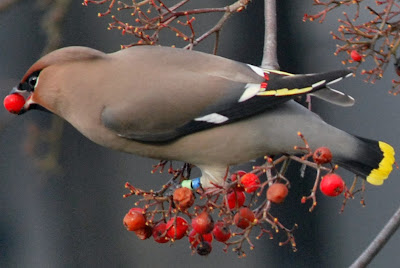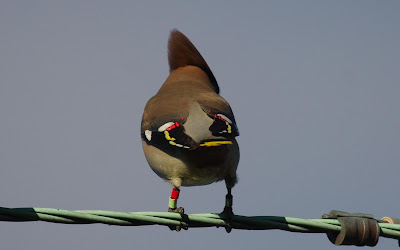It’s a very different picture so far this winter from the last large invasion of 2010/11. See 2 maps below for comparison. Colour-ringed birds have been reported in Ireland, mid-Wales, SW Scotland, Walsall and Warwickshire (2 together) in central England, down the east coast as far as Spurn and Humberside and one across the North Sea near Arnhem in the Netherlands. Despite the huge number of resightings in 2010/11 none were reported in Ireland, Wales or the Netherlands!
Orkney colour-ringed Waxwings (yellow left leg) in Walsall 08/12/12 Andy Purcell
Another Orkney ringed bird in Humberside 08/12/12 Graham Catley.
Two Aberdeen colour-ringed Waxwings in Warwickshire 06/12/12 Stephen Clarkson
Aberdeen Waxwing in Northumberland 10/12/12, Tim Mason
Aberdeen Waxing in Huissen, near Arnhem, the Netherlands 23/12/12 Niek and Chris Klaassen.
Just as interesting is what the map doesn’t show, 100s still around Aberdeen this Xmas (at least 40 colour-ringed birds still present) compared to the near complete exodus in late November 2010 when the snow came big time.
Remarkably one of the mid-Wales birds was actually originally ringed in Fair Isle on 4th November then retrapped in Aberdeen 15th November where the colour-rings blue over black on the left leg were added. Phil Owen then photographed it in Newtown, Powys on 9th December, photo below.
He passed the photo on to local ringer Tony Cross and colleagues who’d been colour-ringing Waxwings at the site that day only to cause them great consternation when they looked at the picture and saw the rings were on the opposite leg to what they had been doing! Remarkably they managed to catch it later in the day to find, much to their relief, that it had been colour-ringed in Aberdeen with same blue/black combination but on the opposite leg!
Nearer home a visit to our neighbouring Tay Ringing Group was made to help them try to ring some of the flock of 800 Waxwings feeding on Yew berries in a Dundee cemetery. It was good to catch up with some old friends but also nice to meet up again with a newer friend……..Dennis The Menace, Waxwing with colour rings red/black/red which had been ringed 10 days previously in Aberdeen. A very appropriate combination and nickname given that the home of the Beano comic and character Dennis The Menace (wearer of a red and black striped jersey for the limited few who may not read the comic on a regular basis) was just round the corner at DC Thomson & Co. in Dundee!
“Dennis The Menace” ringed in Aberdeen 5/12/12 and rtpd in Dundee 15/12/12
More of your photos will feature in Tarry Harry’s Aboyne roundup if he ever gets round to finishing off the “Good, the bad, the ugly……..and the awesome” Waxwing feature posted up previously.
Thank you very much to all who have reported sightings and sent photographs of colour-ringed Waxwings. All are very much appreciated and help monitor the progress and fortunes of some of these Viking invaders during their visit to Britain.
PLEASE CHECK ALL WAXWINGS (AND YOUR PHOTOGRAPHS) FOR COLOUR-RINGED BIRDS AND REPORT THEM TO THE GRG BLOG AT grampianringing@googlemail.com OR raymond@waxwing.fsnet.co.uk.
WE ARE ALSO VERY INTERESTED TO HEAR ABOUT ANY DEAD WAXWINGS FOUND ANYWHERE THIS WINTER TO SEE WHAT GRIM FIGURE WE CAN COME UP WITH COMPARED TO 2010/11.
For a very interesting overview of the movements of Waxwings being colour-ringed in mid-Wales this winter go to midwalesringers.blogspot.com
Raymond Duncan (on behalf of this winter’s GRG Waxwing ringing squad)
.jpg)
.jpg)
.jpg)






























.jpg)





















